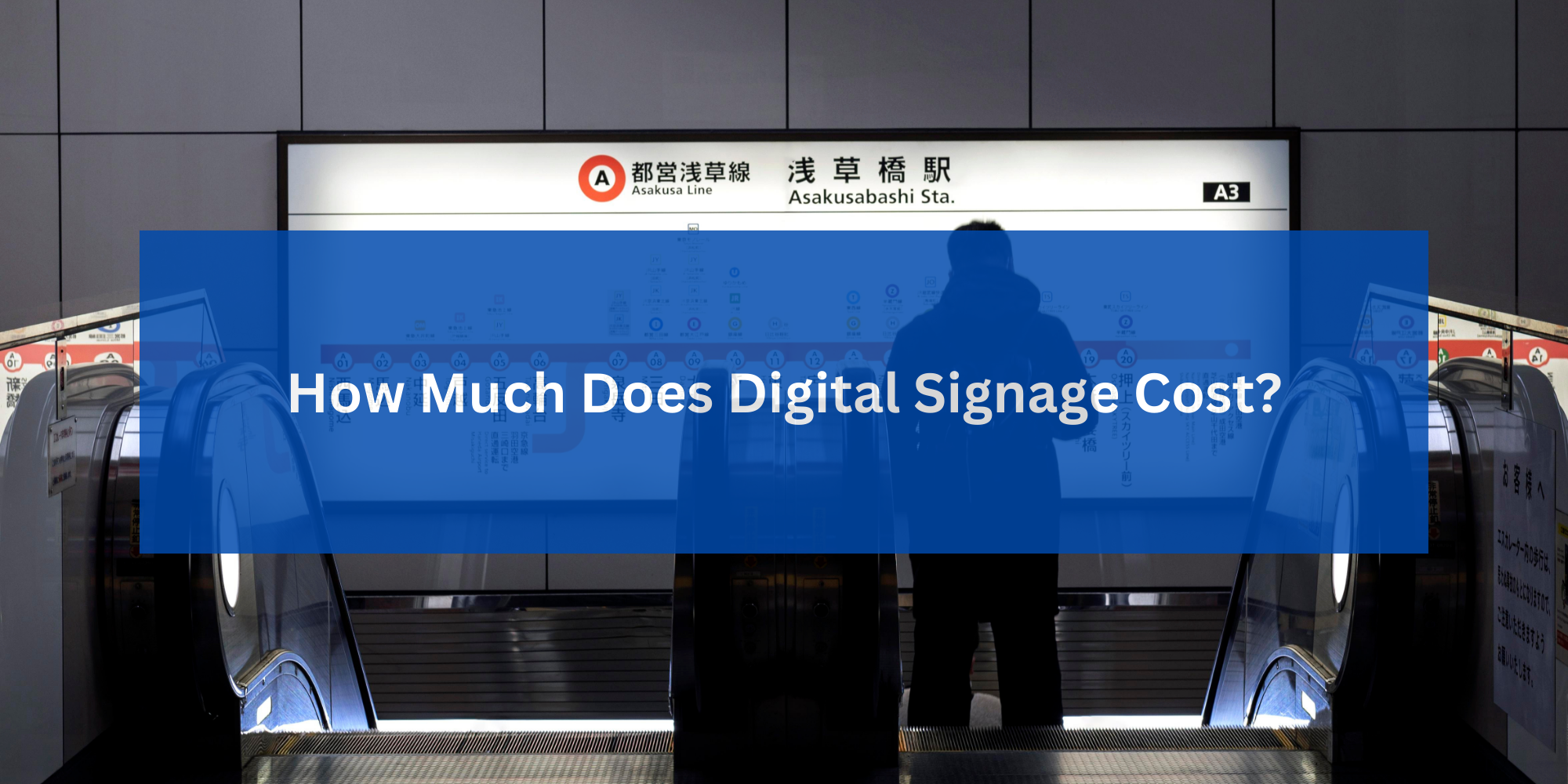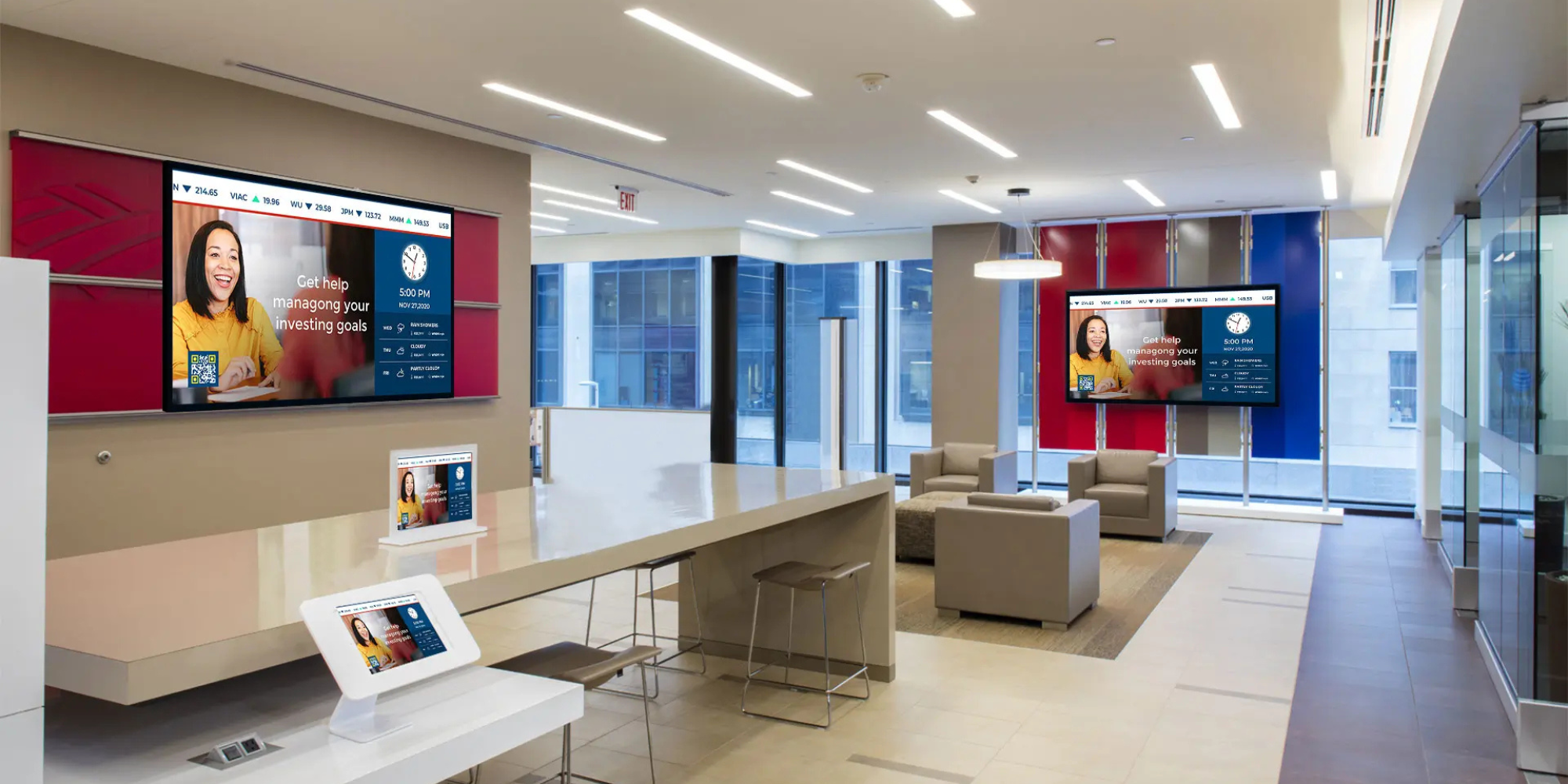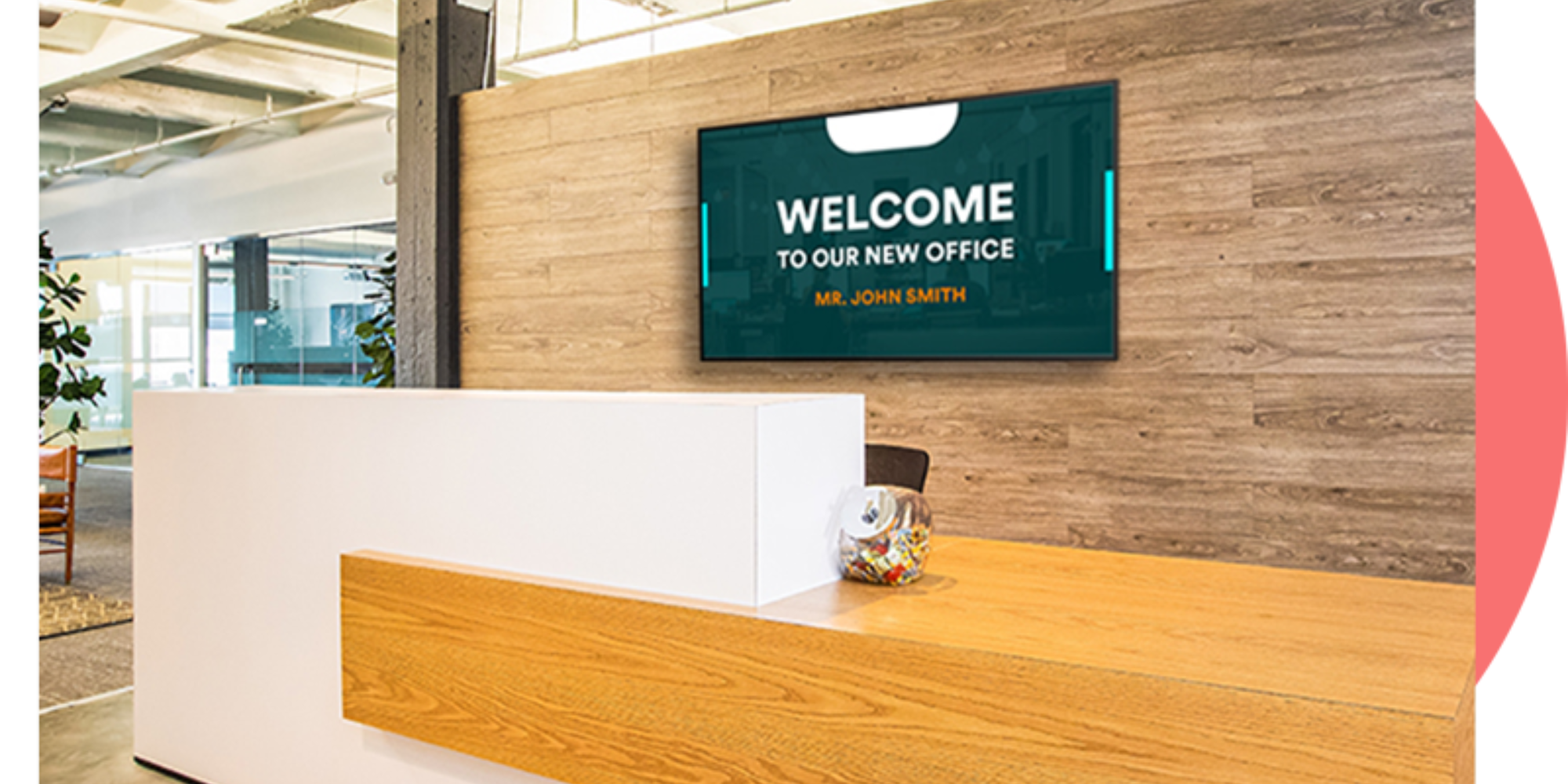
How Much Does Digital Signage Cost in 2025?
Digital signage software transforms how businesses communicate with their audience, strengthening brand promotion and customer engagement. With the global digital signage market projected to reach $45.94 billion by 2030, this technology has proven itself as a long-term investment rather than a temporary trend.
Many businesses hesitate to adopt digital signage due to concerns about upfront costs. While the initial investment requires careful planning, weighing these expenses against the long-term savings and potential return on investment (ROI) reveals a different story. This guide breaks down the cost of digital signage to help you plan your 2025 investment effectively.
Key Factors that Influence Digital Signage Costs
The total cost of a digital signage system depends on several components, including hardware, software, installation, and ongoing maintenance. Below, we’ll examine these elements and provide current cost estimates to guide your decision-making.
Display Screen

The display screen typically represents the largest single expense in your digital signage system, but multiple options exist to fit different budgets.
-
Commercial vs. Consumer Displays
Commercial-grade screens, built engineered for durability and extended use, cost approximately $1,000 to $2,000. Consumer-grade TVs, which can be repurposed for indoor digital signage, range from $500 to $1,500.-
Commercial displays excel in outdoor environments and settings requiring high durability.
-
Consumer-grade TVs perform well in smaller indoor spaces like classrooms or lobbies.
-
-
Screen Size and Type
Larger screens carry higher price tags but may be necessary for visibility in spacious areas. Specialized displays, such as touch screens or video walls, can range from $10,000 to $20,000 depending on complexity. Choose a screen size proportional to your space and content needs to balance digital signage cost with functionality.

Media Player
Media players power your digital signage by displaying content on your screens. Options range from budget-friendly to high-performance devices:
-
Popular Choices:
-
Fire OS: $30 - $80
-
Raspberry Pi: $35 - $160
-
Chrome OS: $150 - $700
-
Windows: $50 - $300
-
Android: $25 - $700
-
Rise Vision Recommendation
Rise Vision recommends the Amazon Signage Stick due to its affordability, performance, reliability, and built-in Mobile Device Management (MDM) capabilities. The MDM feature allows users to easily manage and control their displays remotely, ensuring device and application updates. The Amazon Signage Stick is purpose-built for digital signage and integrates directly with Rise Vision.
The Amazon Signage Stick is currently only available in the United States. You can purchase it here.
For alternative media player recommendations, please check out our hardware list here.
With the release of the new Amazon Signage Stick, Amazon Fire Sticks and Fire TVs should not be used for digital signage moving forward.
Mini PCs are an alternative for advanced setups. Depending on their capabilities, they cost between $100 and $1,400. Choose a player that matches your content complexity and performance requirements.
Rise Vision's Recommended Hardware Solutions
Understanding how much does digital signage cost means considering both software and hardware. Rise Vision offers two turnkey hardware solutions designed to simplify your digital signage deployment while reducing upfront costs.
Rise Vision Media Player
The Rise Vision Media Player is a purpose-built device that delivers reliable performance for digital signage applications. This compact media player includes:
- Cloud-based management for remote configuration and updates
- Built-in security features to protect your content and network
- Flexible purchasing options including Hardware as a Service (HaaS) subscriptions
- Seamless integration with Rise Vision's digital signage software
- Enterprise-grade reliability for 24/7 operation
Pricing: Contact Rise Vision for current Hardware as a Service pricing
Availability: Currently available in the United States and Canada
Best For: Organizations with existing displays looking for a reliable, managed media player solution
Avocor All-in-One Displays
For a complete digital signage solution, Avocor Displays combine a high-quality 4K display with an integrated media player—eliminating the need for separate hardware components.
Key Features:
- No separate media player required – everything is built into the display
- Stunning 4K resolution for crisp, professional content display
- Screen sharing capabilities for wireless presentations and collaboration
- Emergency alert functionality for safety communications
- Cloud management through Rise Vision's platform
- Hardware as a Service options to reduce capital expenditure
Availability: Currently available in the United States and Canada
Best For: New installations, schools needing presentation capabilities, and organizations prioritizing all-in-one simplicity
Hardware as a Service: A Budget-Friendly Approach
Rise Vision's Hardware as a Service model transforms the cost of digital signage from a large capital expense into predictable monthly subscriptions. This approach:
- Eliminates high upfront hardware costs
- Includes ongoing support and maintenance
- Provides hardware refresh cycles to keep technology current
- Simplifies budgeting with fixed monthly payments
- Reduces IT burden with fully managed devices
Whether you choose the Rise Vision Media Player for existing displays or Avocor all-in-one solutions for new installations, both options integrate seamlessly with Rise Vision's software platform and include comprehensive support.
Cabling and Mounts
-
Cabling: HDMI cables cost around $13 for a 6-foot length, but wall installations for hidden wiring can add to your budget.
-
Mounts: Prices vary by type, with commercial mounts costing over $200 and consumer mounts ranging from $50 to $150. Select mounts that suit your display’s placement and angle.
You can also opt to substitute a media player for a mini PC, depending on the setup of your digital sign. Keep in mind that this will be more expensive, but will support more complex and advanced applications. Mini PCs cost around $100 for basic models to $1,400 for powerful units.

Installation
Installation costs depend on the complexity and scale of your digital signage setup:
-
Small setups (1-2 screens): $200+
-
Extensive, complex integrations: $2,000 - $10,000
Get multiple quotes from installers to find the best value for your project.
Software & Licensing
Digital signage software enables you to manage and optimize content effectively.
-
Cloud-Based Software (SaaS): Subscription-based options start at $7 per monthly screen. These platforms handle backend maintenance and updates.
-
Features to Consider include scheduling tools, templates, and security features. Ensure the software is scalable and contains reliable customer support.
Digital Signage Software Pricing: Rise Vision vs. Competitors
When evaluating the cost of digital signage, software pricing plays a significant role in your total investment. Here's how Rise Vision's pricing compares to other leading platforms:

What This Means for Your Budget:
For a 10-screen deployment over one year, here's what you can expect to invest in digital signage software pricing:
- Rise Vision: $840/year ($7 × 10 screens × 12 months)
- Look Digital Signage: $1,620/year ($13.50 × 10 screens × 12 months)
- ScreenCloud: $2,400-2,880/year ($20-24 × 10 screens × 12 months)
Rise Vision delivers the most competitive digital signage price point while maintaining comprehensive features, free training, and exceptional support—making it the cost-effective choice for schools, healthcare facilities, and businesses managing multiple displays.
Content Creation

Content costs vary widely based on complexity:
-
Basic Content: Static images and graphics are cost-effective.
-
Advanced Content: Interactive and video-based content requires skilled professionals like graphic designers or video editors.
Some software platforms include built-in templates that may not align with your branding needs.
IT Support & Maintenance Personnel
Regular maintenance and troubleshooting are essential to keep your digital signage running smoothly:
Provisioning
Provisioning involves connecting and configuring your hardware for digital signage use.
This process requires technical knowledge of internet connectivity and device networking. If you don’t have an in-house IT team to handle this task, you may need to outsource it, costing you roughly $250 - $350 per display.
If you’re using Android digital signage, you might be able to save on provisioning costs. These devices support easy USB provisioning, which you can complete yourself.
Integration
You’ll also need to integrate all the required components into your digital signage system, which can be complex and time-consuming.
While you can do this yourself with easy-to-integrate software solutions, we recommend outsourcing the process to expert IT staff to avoid more costly problems down the road.
Software Onboarding

Most digital signage software is designed to be easy to use, even without IT experience. However, if it's your business's first endeavor with digital signs, learning how to use and operate the software will be a learning curve.
That said, onboarding and training your staff to use digital signage software should be an expense that you are prepared for.
Troubleshooting and Maintenance
Digital signage systems require ongoing attention. You'll likely encounter technical issues, whether software or hardware-related.
You want an IT team on standby to troubleshoot issues quickly and conduct routine maintenance to keep the system functioning correctly.
The cost of IT support will depend on the scale of your network and the scope of their responsibilities.
Life Cycle
When calculating digital signage, you must also account for its life cycle. An essential digital sign will last five years before the hardware degrades, so you’ll eventually need to pay for repairs, replacements, or upgrades.
Commercial-grade digital signage may last longer because they’re made to withstand rigorous use and extreme conditions.
Hidden Costs
When budgeting for digital signage, account for additional expenses such as:
-
Graphic design and video production
-
Licensing fees for photos or software-supported content
-
Hardware repairs or upgrades after 5+ years
Free digital signage software may seem appealing but often lacks essential features and support, potentially increasing costs later.
What Rise Vision Customers Say About Value and Performance
Real-world feedback from organizations using Rise Vision demonstrates the platform's reliability, ease of use, and cost-effectiveness:
Easy Deployment and Management
"My company, RelianceAV, deployed 16 displays for Mount Vernon Middle and the client was extremely impressed! The school uses it extensively to convey school events and positive messaging to the students. Users found the content management platform to be very intuitive and Rise Vision continuous development of templates makes it quick and easy to keep the content fresh and engaging. Highly recommend!"
— Chet Neal, RelianceAV
Daily Reliability for Schools
"Rise Vision is an amazing tool! It's incredibly easy to set up and use, and the templates make creating and updating content effortless. I use it every day at our school, and it has never let me down—completely reliable with no bugs or issues. The platform runs smoothly, saves me time, and makes sharing announcements and updates simple and visually engaging. I couldn't ask for a better solution for school communication!"
— C. Camacho, School Administrator
Professional Results with Strong Support
"Rise Vision is an easy-to-use and reliable digital signage platform. The templates make it simple to create professional displays, and the ability to manage screens remotely is a huge plus. Customer support is responsive and helpful whenever questions come up. While some templates have limited customization and there can be a bit of a learning curve for advanced features, overall it's a great solution for keeping content fresh and engaging."
— Brian McGahan
These testimonials highlight what matters most when evaluating digital signage cost: ease of use, reliability, template quality, remote management capabilities, and responsive support. Rise Vision's combination of affordable digital signage pricing and comprehensive features delivers measurable value for organizations of all sizes.
Is Digital Signage Worth the Price?
Digital signage offers unmatched flexibility and impact for businesses aiming to enhance communication and engagement. For industries like manufacturing, integrating digital signage with manufacturing dashboard software can take efficiency to the next level. By displaying real-time KPIs, production metrics, and performance data, businesses can streamline operations, ensure transparency, and quickly address bottlenecks. Whether it's monitoring machine output, tracking inventory levels, or improving workplace safety, this combination enhances decision-making and keeps teams informed at a glance.
Rise Vision’s Hardware as a Service combines hardware and software into scalable subscriptions, reducing initial costs and simplifying management. With comprehensive support and a 14-day free digital signage software trial, Rise Vision helps businesses test and implement digital signage confidently.
Sign up today to explore how digital signage can elevate your business communication strategy.
Frequently Asked Questions About Digital Signage Costs
1. What is the total cost to set up digital signage for the first time?
The initial cost to set up digital signage typically ranges from $680 to $3,400+ per screen, depending on your hardware choices. A basic setup includes a display ($500-$2,000), media player ($50-$700), mounting hardware ($30-$200), installation ($200-$500), and software subscription (starting at $7/month with Rise Vision). Schools and businesses can reduce upfront costs by choosing Rise Vision's Hardware as a Service option, which spreads expenses into manageable monthly payments.
2. Are there hidden costs with digital signage that I should budget for?
Yes, several ongoing costs should be factored into your digital signage budget. These include monthly software subscriptions ($7-$24 per screen), content creation (if not using free templates), hardware maintenance or replacements after 5+ years, and potential IT support for troubleshooting. However, Rise Vision minimizes these hidden costs by offering free training, free support with response times under one business hour, and 560+ free templates—eliminating many expenses that competitors charge for.
3. How does digital signage software pricing compare between different providers?
Digital signage software pricing varies significantly between providers. Rise Vision starts at $7 per screen monthly with no contracts, while competitors like Look Digital Signage charge $13.50+ per screen and ScreenCloud ranges from $20-$24 per screen monthly. For a 10-screen deployment, this translates to $840/year with Rise Vision compared to $1,620-$2,880/year with competitors—making Rise Vision the most cost-effective choice for schools, healthcare facilities, and businesses managing multiple displays.
More From Our Blog
-

Optimizing School Announcements with Screen-Sharing Technology
In today’s fast-paced digital age, staying informed about school announcements has become more efficient thanks to screen-sharing technology. Forget about missed memos or ignored notices—this modern[…]
Read More -

How Effective is Digital Signage?
Digital signs are revolutionizing. That's the short answer. But if you're trying to convince leadership to invest in screens for your school hallways, hospital waiting areas, or manufacturing floor,[…]
Read More -

10+ Office Welcome Sign Ideas
Getting a welcome sign on your office display shouldn't take all afternoon. Rise Vision makes it pretty straightforward: pick a template, swap in your logo, and push it to your screen. Done. The[…]
Read More
Keep Your Displays Interesting – Pick New Templates Every Week!
Every week, we send template recommendations that will make you look great and improve your audience experience. And the best part, they save up to 16 hours of content creation time every week!
12,300+ Organizations Trust Rise Vision, You Can Too
Schedule a Free Demo
You deserve the #1 all-in-one platform for digital signage, screen sharing, and emergency alerts.



































